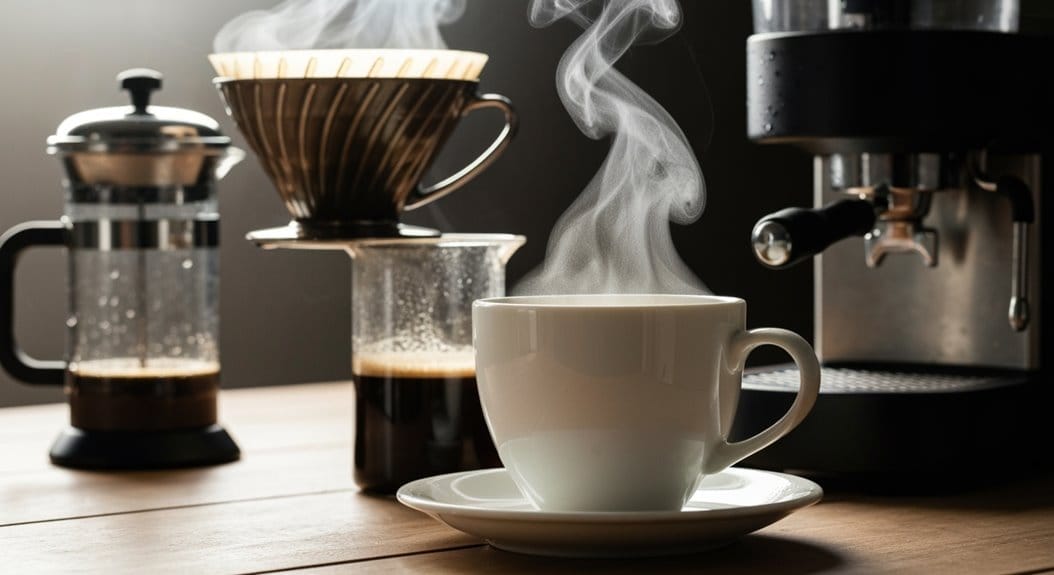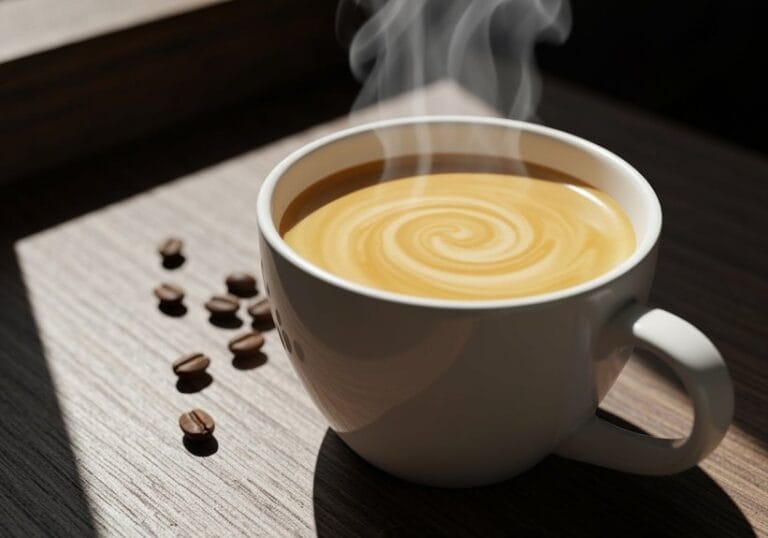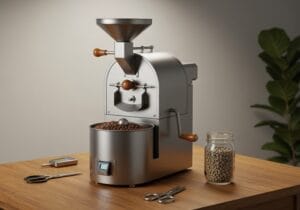Light roast coffee actually might have more caffeine than dark roast, and it’s not just a tale brewed over a cuppa! Yeah, those little beans are smaller and denser, which means folks could get more caffeine per scoop! Crazy, right? So when you’re scooping in that Monday morning rush, don’t assume dark roast is the superhero of caffeine. But hey, if you’re curious about how brewing methods come into play and cause all sorts of caffeine shenanigans, there’s more to sip on!
Key Takeaways
- Light roast coffee retains caffeine stability, meaning there is no significant loss during roasting.
- By volume, light roasts tend to have a higher caffeine concentration due to their smaller size and density.
- Dark roasts occupy more space but don’t have more caffeine when measured by weight.
- Espresso extraction yields high caffeine levels, regardless of roast level, while cold brew typically has less caffeine.
- Measuring coffee by weight ensures consistency in caffeine content, making light roasts often more potent per scoop.
The Science Behind Roasting Levels and Caffeine
In regards to coffee roasting, one might think it’s just about how dark you want your brew—like picking the right outfit for an initial date.
But oh, let me tell you, it’s like picking a prom dress with lots of unexpected twists! While the roasting process does cause some mass loss (thanks water!), the caffeine in those beans? It’s like a determined gym-goer—stays put! Interestingly, caffeine concentration is typically higher in blonde roast coffee when measured by volume compared to dark roast.
The real kicker here is bean density. Light roasts, being denser and smaller, might just pack a little more caffeine per scoop than their laid-back dark roast buddies. Additionally, caffeine content remains stable during roasting regardless of roast level, so the differences in caffeine aren’t as drastic as one might expect.
Measuring Caffeine: Weight vs. Volume
How can something as simple as a cup of coffee turn into a math equation?
Turns out, measuring caffeine isn’t just about guesswork! Weight versus volume? It’s a coffee conundrum! When you measure by volume—using scoops or cups—your caffeine content jumps around like a hyper puppy, thanks to bean sizes and roasting. Talk about measuring accuracy chaos!
However, when you invest in a scale and measure by weight, ta-da! You get dosing consistency, every time. No more guessing if your morning brew has the kick of a mule or the gentleness of a kitten!
Invest in a scale and enjoy coffee consistency—no more surprises, just the perfect brew every time!
Plus, a dark roast might take up more space but weigh the same, making weight the real MVP in your quest for caffeine perfection!
Brewing Methods and Their Impact on Caffeine Content

Ready to brew up a storm? In terms of coffee, the way you brew it can totally change your caffeine game!
Take espresso extraction, for example—it’s like the Hulk of coffee! With up to 4200 mg/L of caffeine, a single ounce packs about 60-65 mg. Boom! This potent brew offers higher caffeine levels than many traditional coffee methods, making it a favorite for those seeking a quick energy boost.
On the flip side, we have cold brew, which is like that mellow friend who takes their time—sipping away at a modest 15-20 mg per ounce. Even though it brews for ages, the cold method’s lack of heat means it’s less caffeinated than espresso. Fun fact: If you steep cold brew too long, you might end up with a diluted version of yourself, like that sad cup at the end of a long party! Remember, brewing time can significantly impact caffeine extraction.
Debunking Myths: Common Misconceptions About Coffee Caffeine
Ever wondered why everyone seems to think dark roast coffee is the caffeine powerhouse, when in reality, it might just be a slight mischief-maker in your mug?
It’s time to tackle those pesky caffeine misconceptions, folks! Here’s the scoop: caffeine stays pretty stable during roasting. Yeah, it doesn’t just up and leave when the beans get hot!
The trick is that while dark roasts lose some water and density, the caffeine? It’s chillin’ just fine!
If you’re measuring by scoops (guilty as charged!), light roasts seem to pack a bigger punch—thanks to those plump little beans.
Frequently Asked Questions
Does Caffeine Tolerance Affect How I Feel After Drinking Coffee?
Caffeine tolerance considerably influences individual responses to coffee. Personal metabolism and caffeine sensitivity determine how stimuli are perceived, with habitual consumers experiencing diminished effects, while occasional drinkers often feel heightened alertness or jitteriness following consumption.
Can Decaffeinated Coffee Still Affect My Caffeine Levels?
Decaf coffee can still affect caffeine levels, as it contains small amounts of caffeine. Although the quantities are considerably lower than regular coffee, sensitive individuals or those monitoring intake should consider their total consumption carefully.
How Does Grind Size Influence Caffeine Extraction?
Grind consistency greatly influences caffeine extraction efficiency. Finer grinds improve surface area and contact with water, optimizing extraction methods. Conversely, coarser grinds minimize caffeine release, underscoring the critical role of grind size in brewing outcomes.
Are There Health Benefits Linked to Higher Caffeine Consumption?
Higher caffeine consumption is linked to diverse health benefits, including improved cognitive function and an energy increase. It amplifies alertness, mental performance, and may lower the risks of neurodegenerative diseases and cardiovascular issues.
Does Caffeine Content Vary Among Different Coffee Brands?
Caffeine content varies among different coffee brands due to factors like caffeine sourcing, bean origins, and processing methods. Brand comparisons reveal that brewing techniques and measurement methods greatly influence the perceived caffeine levels in the final product.





